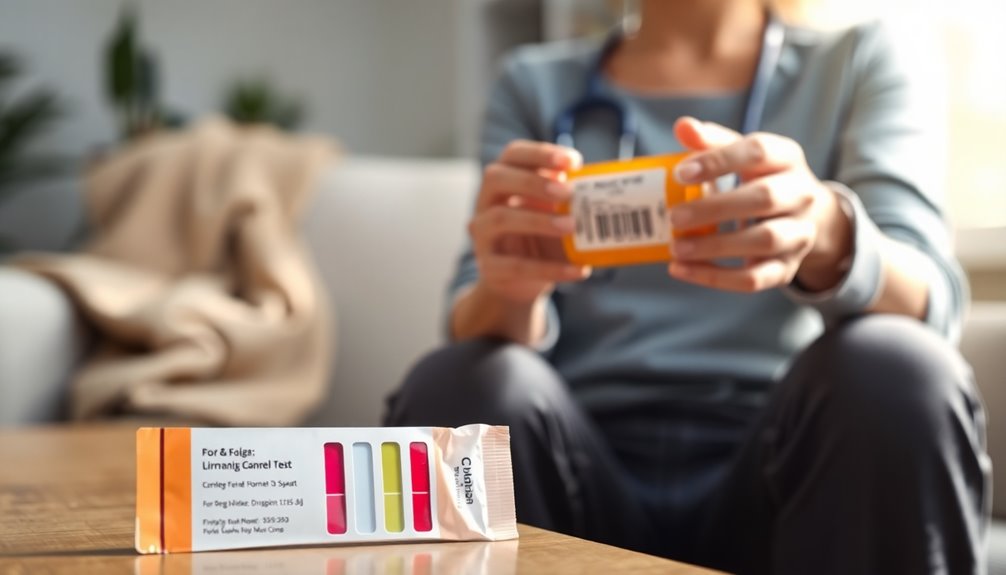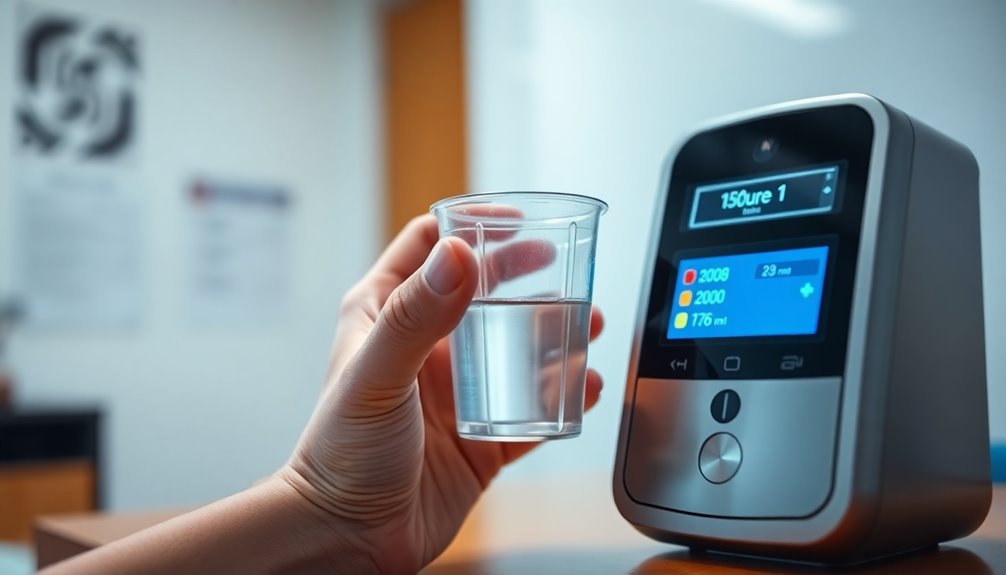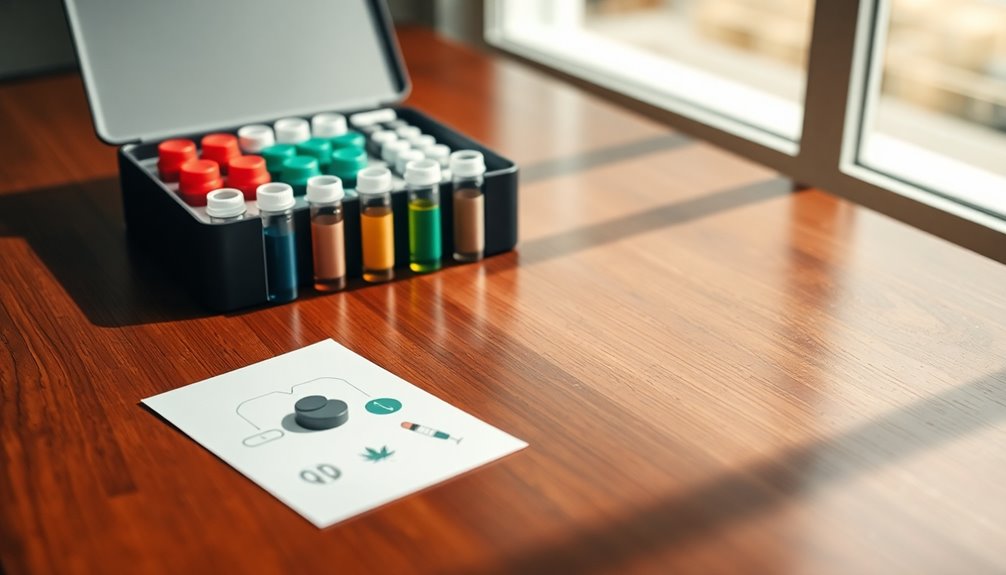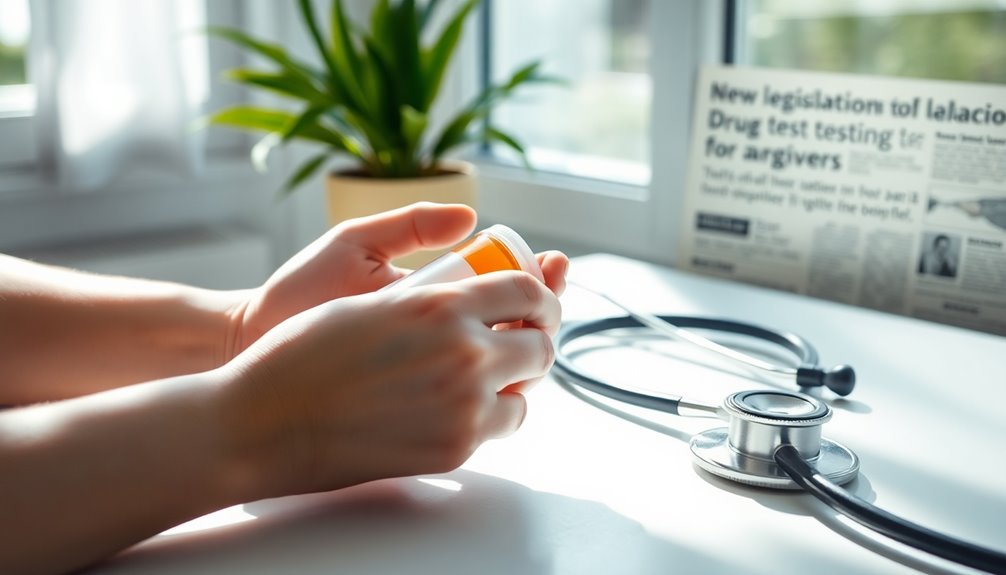Yes, caregivers often get drug tested as part of the hiring process. This helps guarantee the safety of the individuals they’ll be caring for. Common methods include urine and hair tests, each detecting drug use over different time frames. As regulations change, the types of drugs tested can vary, too. Understandably, steering through this process can come with its own challenges, but there are effective solutions to address them. You’ll find more information about this below.
Key Takeaways
- Many caregiver agencies implement drug testing to ensure the safety and well-being of those in their care.
- Common drug testing methods include urine tests and hair sample analyses, each offering different detection timelines.
- Urine tests detect recent drug use within the last 72 hours, while hair tests can identify substances used up to 90 days prior.
- The legalization of substances like marijuana has prompted agencies to enhance drug testing protocols for caregivers.
- Random drug testing may also be employed for caregiver positions to maintain ongoing safety standards.
Importance of Drug Testing for Caregivers

When it comes to hiring a caregiver, guaranteeing the safety of your loved ones is paramount. That’s why drug testing has become increasingly important for nanny candidates. Parents are recognizing that implementing drug tests can help identify potential substance abuse issues before you bring someone into your home.
This step complements standard pre-employment background checks, offering an additional layer of security. Many nanny agencies now provide drug screening options, reflecting this growing emphasis on rigorous caregiver screening.
Methods of Drug Screening

When it comes to drug screening for caregivers, urine tests and hair sample analyses are the most common methods.
You’ll find that urine tests can reveal recent drug use, while hair tests provide a longer history.
Both methods target a range of substances, ensuring a thorough evaluation of a caregiver’s drug use.
Urine Testing Procedures
Although urine testing is widely used for drug screening, understanding the process can clarify its importance in caregiver employment. The procedure begins with the collection of a urine sample in a clean environment. Temperature checks may follow to verify the sample’s validity. Results are usually available within two business days, allowing quick employment decisions.
| Substance | Detection Window |
|---|---|
| Amphetamines | Up to 72 hours |
| Marijuana | Up to 72 hours |
| Cocaine | Up to 72 hours |
| Opiates | Up to 72 hours |
| Other substances | Varies by substance |
This thorough test screens for various drugs, helping maintain a safe environment for caregivers and those they serve.
Hair Sample Analysis
Hair sample analysis offers a reliable method for drug screening, especially for caregivers, as it can detect drug use over a longer period. This method identifies drugs embedded in hair from the bloodstream, allowing for a detection window of up to 90 days prior to the test.
For hair testing, you’ll need about 100 mg of hair, typically collected from the scalp, and results can take up to five days. Unlike urine tests, which only reveal recent drug use within the past 72 hours, hair tests provide a more extensive view of substance use over time.
Commonly screened substances include amphetamines, marijuana, cocaine, and opiates, making hair sample analysis a preferred choice for ensuring safety and compliance in caregiving roles. Additionally, understanding the divorce costs involved in legal proceedings can significantly influence a caregiver’s financial planning during challenging times.
Types of Drugs Tested
Caregivers often face drug testing that typically screens for a range of substances to confirm safety and compliance in their roles.
The most common method of drug screening is the 10-panel test, which checks for:
- Amphetamines
- Cocaine
- Benzodiazepines
Urine tests can detect drug use within the past 72 hours and usually provide results in two business days.
Alternatively, hair tests can identify substances used up to 90 days prior, but results may take up to five days.
While the specific substances tested can vary by the diagnostic company, these methods confirm that caregivers maintain the necessary standards of safety and reliability in their positions.
Comparison of Hair Tests and Urine Tests

When you’re considering drug testing methods, it’s important to understand the differences between hair tests and urine tests.
Each method has its own detection timeframe, sample collection procedure, and drug coverage, which can influence your decision.
Detection Timeframes Comparison
Although many people rely on urine tests for immediate drug detection, hair tests offer a more extended window for identifying past substance use. Urine tests can typically detect drug use within the last 72 hours, while hair tests can identify substances used up to 90 days prior. This means you could pass a urine test but still have traces of drugs in your hair.
- Urine tests yield results in about two business days.
- Hair test results may take up to five days to process.
- Hair tests focus on specific drugs, unlike the broader urine test panel.
When considering a drug test, it’s essential to understand these timing differences to better prepare for what might come.
Sample Collection Procedures
Understanding the sample collection procedures for drug testing is essential for anyone undergoing these tests. Here’s a quick comparison of hair tests and urine tests:
| Aspect | Urine Tests | Hair Tests |
|---|---|---|
| Sample Size | Urine sample | 100 mg of hair |
| Result Time | Within two business days | Up to five days |
| Detection Window | Past 72 hours | Up to 90 days |
| Drug Types Tested | Amphetamines, marijuana, cocaine, opiates, barbiturates | Amphetamines, marijuana, cocaine, opiates |
Both procedures are facilitated by background screening companies to guarantee compliance and maintain a chain of custody. Choosing the right drug test based on your situation is key, as you might pass one test and fail another.
Drug Coverage Differences
Choosing between urine tests and hair tests involves understanding their different drug coverage capabilities. As a care provider, knowing these differences can help you make informed decisions.
- Urine tests: Quick results in two business days, detecting drug use from the past 72 hours.
- Hair tests: Results may take up to five days, identifying drug use up to 90 days prior.
- Detection range: Urine tests check for additional substances, while hair tests offer a broader overview of long-term drug use.
Candidates might pass a urine test but fail a hair test due to these varying detection windows.
Choosing the right test based on potential drug use timeframe is essential for effective screening in caregiving environments.
Types of Drugs Tested

When it comes to caregiver drug testing, a variety of substances are typically screened to guarantee a safe environment for patients. Commonly tested drugs include amphetamines, marijuana, cocaine, and opiates.
Many employers utilize a 10-panel drug screen, which also detects barbiturates and benzodiazepines.
Urine tests are the most frequent method used to identify drug metabolites, while hair tests can reveal drug use over an extended period, up to 90 days.
The specifics of drug testing can vary depending on the diagnostic company’s methods and the substances they include.
Employers often implement random drug tests or screenings tailored to job requirements, especially for caregiver positions, to ascertain the highest standards of safety and care.
Impact of New Legislation

As new legislation legalizing marijuana rolls out in various states, caregivers may find themselves managing changes in drug testing protocols that could impact their employment.
You’ll need to keep an eye on how these legal shifts affect your screening practices.
- Increased demand for thorough drug testing
- Evolving policies around substance legality
- Necessity for staying informed about legal updates
Being aware of these developments is essential. Community engagement can play a crucial role in understanding these changes and sharing experiences that may help navigate the new landscape.
They can influence your job opportunities and the requirements you face during drug testing. Families and agencies must also remain compliant with updated policies to guarantee a smooth caregiving experience.
For ongoing updates on this legislation and its implications for drug testing, keep an eye on APNA newsletters.
Barriers Faced by Disabled Individuals in Employment

Despite advancements in workplace inclusivity, disabled individuals still encounter significant barriers in employment. Preconceived notions about their capabilities often hinder their chances in the job market. Accessibility issues in both software and physical environments further limit opportunities. You might also face challenges during the onboarding process, including drug testing, which can disproportionately affect you. Discriminatory attitudes from employers may lead to bias and unfair treatment, while emotional distress from encounters at drug testing sites can worsen your experience. It’s important to recognize that narcissistic behaviors can also manifest in the workplace, affecting the treatment of disabled individuals.
| Barrier Type | Description | Impact on Employment |
|---|---|---|
| Preconceived Notions | Employers doubt capabilities | Reduced job opportunities |
| Accessibility Issues | Lack of adaptive technologies or facilities | Limited job options |
| Onboarding Challenges | Complex processes, including drug tests | Increased stress |
| Discriminatory Attitudes | Bias during hiring | Unfair treatment |
| Emotional Distress | Stress from confrontational experiences | Lower confidence |
Seeking Solutions for Drug Testing Challenges

Finding effective solutions for drug testing challenges can greatly improve the experience for caregivers.
To navigate these hurdles, consider the following strategies:
- Communicate openly with recruiters about your needs for testing accommodations.
- Utilize supportive labs like LabCorp, known for their understanding of caregiver requirements.
- Advocate for your rights, ensuring you have access to necessary supplies and assistance during the process.
Recommendations for Caregiver Dependent Individuals

When managing drug testing, caregiver-dependent individuals should prioritize clear communication with their employers. Advocating for your personal rights during the process is vital. Request support, and choose medical labs like LabCorp for testing, as they’re more accommodating than third-party sites. Sharing your experiences can foster understanding and inclusivity. Additionally, it’s important to understand that state-specific asset division laws can impact financial stability during this process.
| Recommendation | Action Item | Benefits |
|---|---|---|
| Communicate Clearly | Discuss needs upfront | Prevent misunderstandings |
| Choose the Right Lab | Opt for LabCorp | Better accommodations |
| Advocate for Yourself | Request necessary support | Empowerment |
| Share Experiences | Raise awareness | Promote inclusivity |
| Avoid Third-Party Sites | Stick to reliable labs | Guarantee proper care |
Frequently Asked Questions
Do You Need to Pass a Drug Test to Be a Caregiver?
Yes, you usually need to pass a drug test to become a caregiver. Many employers require this as part of their pre-employment screening to guarantee the safety of those in your care.
The tests often focus on various substances, and a common method is a 10-panel urine test.
Additionally, some employers may conduct random drug tests after you’re hired, so it’s important to be prepared and maintain a clean lifestyle.
Do Health Care Workers Get Drug Tested?
Imagine a ship sailing through stormy seas, where the captain must guarantee the crew remains fit for duty.
In health care, you’re part of that crew, and drug testing is an essential part of your journey. Most health care workers, including you, undergo drug tests during hiring, and some face random checks to keep the waters calm.
This practice helps protect those in your care, guaranteeing a safe and secure environment for everyone on board.
What Jobs Are Least Likely to Drug Test?
If you’re exploring jobs that are least likely to require drug testing, consider positions in the arts and entertainment sectors, like acting or music.
Freelance gigs, such as rideshare driving or delivery services, often have minimal testing requirements too.
Many technology jobs in startups might skip drug tests, focusing more on skills.
Retail and hospitality roles, especially in smaller businesses, mightn’t enforce testing either, prioritizing qualifications and experience over drug policies.
Does Home Health Aide Drug Test?
You might think home health aides are dodging drug tests like ninjas in the night, but that’s not the case!
Many organizations do require drug testing for these important roles. You’ll likely face a pre-employment test, checking for substances like cocaine or marijuana.
And guess what? Random tests could pop up later too!
Conclusion
In the end, drug testing for caregivers is essential for ensuring safety and quality care. As the saying goes, “an ounce of prevention is worth a pound of cure.” By understanding the methods and types of tests, you can navigate the challenges that come with drug screening. Embracing solutions and advocating for fair practices not only helps caregivers but also supports the disabled individuals who depend on them for care. Your proactive approach can make a real difference.









